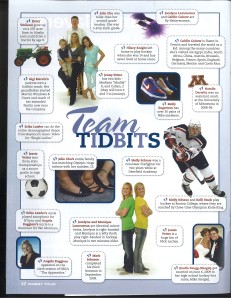 Last week I attended the first-ever Ice Hockey Summit: Action on Concussion. The program was impressive and invited speakers in included NHL referee and players, coaches, neurologists, neurosurgeons, neuropsychologists, brain physiologists, sport scientists, coach educators, helmet engineers and manufacturers, biomechanists, researchers, clinical psychologists, athletic trainers, sports medicine and family practice doctors, and representatives from the International Ice Hockey Federation, USA Hockey and Hockey Canada.
Last week I attended the first-ever Ice Hockey Summit: Action on Concussion. The program was impressive and invited speakers in included NHL referee and players, coaches, neurologists, neurosurgeons, neuropsychologists, brain physiologists, sport scientists, coach educators, helmet engineers and manufacturers, biomechanists, researchers, clinical psychologists, athletic trainers, sports medicine and family practice doctors, and representatives from the International Ice Hockey Federation, USA Hockey and Hockey Canada.
The New York Times wrote two pieces on the summit which are informative (click here and here).
Here are a few of the important messages that everyone should know about concussions.
- A concussion is a traumatic brain injury and should be treated and taken seriously. The CDC has a host of wonderful and free materials about concussions that can be accessed here, including specific information about sports concussions.
- Mouth guards do NOT protect athletes from concussions. Helmets protect from linear focal point hits, but don’t protect from concussions (which primarily are sustained from rotational and linear forces) as well as we think they do.
- All sport stakeholders should be educated about the signs and symptoms associated with concussions. Concussions in children and youth is a serious issue because the brain is still developing and therefore more vulnerable to lasting concussive side effects (15% of children do not fully recover from concussions).
- If an athlete is suspected of having a concussion, he/she should NOT Return To Play (RTP) in that game or that day. Period. “When in Doubt, Sit Them Out!
- The decision for Return To Play should only be given by a trained medical professional, not by coaches, parents or placed in the hands of the athlete. RTP is a medical decision. Both physical and cognitive rest are needed following a concussion. Even when an athlete is asymptomatic, the brain is still recovering. Returning to play too early places the athlete at greater risk for another concussion, potentially long lasting side effects, and increases the likelihood of a full recovery.
- A concussed brain is a metabolic crisis which creates a “chemical soup” that bathes the brain. Metabolic recovery of the brain Lags behind 30-45 days symptomatic resolution. What this means is that even when an athlete shows no signs of concussion and is physically recovered, the brain is still healing.
- Multiple brain injuries, like repetitive concussions, places the individual at greater risk for Chronic Traumatic Encephalopathy (CTE)–an emerging disorder that was frightening to hear about. For more about CTE and the work of Dr. Ann McKee and colleagues at Boston University School of Medicine click here,
- A cultural and behavioral shift needs to occur in hockey to help reduce the incidence of concussions and protect athletes. The belief that brutal hits and fights are entertaining, especially in professional hockey, creates an environment in which illegal should-to- head hits are tolerated, not penalized, and fights are allowed to continue (18% of concussions happen during fights). This belief in turn trickles down to the youth level, where such behaviors are learned, valued, and taught. Evidence that behavior around illegal and dangerous behaviors can be changed as the Hockey Education Program in Minnesota has shown with the implementation of the Fair Play Point system.








